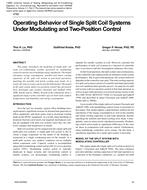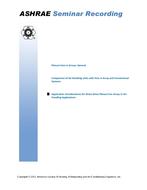Click here to purchase
The design, construction, and verification of commercial net-zero energy buildings is growing rapidly. This paper examines how the State of Oregon isworking to both encourage and address hurdles to net-zero energy construction. For cities and states with aspirations or quickly approaching deadlines toreach “zero”, Oregon’s experience can provide examples of similar problems and solutions. Building energy codes provide the foundation for net-zero energybuildings. Oregon’s statewide energy code process will ensure earlier adoption of advanced model building energy codes. Additionally, at time of permit allnew commercial buildings will be required to identify the renewables needed to achieve net-zero energy using the Architecture 2030’s ZERO Code Calculatortool. The cumulative energy savings are substantial. As our statewide energy code increases awareness of renewable energy needs other statutory andrulemaking hurdles must also be addressed for buildings to successfully achieve net-zero energy. Issues include metering, balancing on-site and off-siterenewables, and grid interaction among other technical issues. Oregon’s Consumer-Owned Utilities (COU’s) are only required to net-meter facilities with agenerating capacity of 25 kW or less. Some net-zero energy-ready structures may require systems greater than 25 kW. Oregon Investor-Owned Utilities(IOU’s) have a much higher threshold at 2 MW. Cumulative limits for maximum net-metered generating capacity also apply. Coupled with Oregon’sclimate-action targets, the Oregon framework needs adjustment to allow for statewide, on-site net-zero energy. Successful net-zero energy buildings, for themost part, have been owner-occupied with a single electric meter. Multi-tenant buildings that can achieve net-zero energy today need the means to legallydistribute net-metered renewable energy. Oregon’s rules allow aggregation of meters, but only to the same customer. These rules would require modificationto include virtual net-metering for multi-tenant buildings. Net-zero energy is not possible for many buildings using only on-site renewables. We review theother factors limiting achievement of net-zero energy with on-site renewables and how use of off-site renewables can be more efficient. Architecture 2030 hasset a framework for weighting the “value” off-site renewables. However, the regulatory issues of off-site renewables, community solar, micro-grids, storage,and distributed generation cross the boundaries of multiple agencies and regulatory bodies. Balancing these interests requires a concerted effort. Getting morebuildings to net-zero energy requires more than development of advanced energy codes or mandating renewables. Regulatory hurdles can, and must, beovercome for jurisdictions to achieve their zero-impact targets. Action cannot wait until energy codes reach their limits.
Citation: 2020 Virtual Conference Papers
Product Details
- Published:
- 2020
- Number of Pages:
- 9
- Units of Measure:
- Dual
- File Size:
- 1 file , 1.5 MB
- Product Code(s):
- D-VC-20-C001


